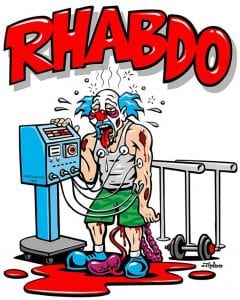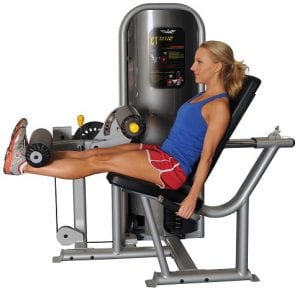This is an article that has been swirling around my head for a while. Don’t expect hugely practical things from it. Rather, it was just an attempt to answer two questions. First, why do leg extensions hurt so much? I mean locally, in the quads, for the same reps at the same effort they hurt far more than other exercises. Second, what do blood flow restriction (BFR, Kaaattttssssuuuuu!!!), speed skating and leg extensions have in common?
Table of Contents
Blood Flow Restriction (BFR)
Ok, for the 3 people who don’t know what BFR is, it’s a relatively new method of training where you basically use pressure to reduce blood flow to the muscle and then use relatively light loads for training.
And research has generally found that it provides similar hypertrophy gains to muscle as heavier training and does so with lighter loads with various mechanisms being involved. Please note that the size gains are, at best, identical but not greater. And you don’t get the strength gains you’d get from lifting real weights since you aren’t training the neural components.
Now, BFR is nice in that it does reduce joint strain which can be fantastic if you have a joint injury or deliberately need to do such.
But it has drawbacks. One is set up since you’re having to go to the trouble to get everything tied off. I’m not sure the average trainee can get the pressure right since it tends to be pretty specific. Cutting off blood flow to muscles is not a good thing. Necrosis anybody? And while excruciatingly minor in the big scheme, there are two case studies of rhabdomyolysis occurring with BFR. Mind you, that’s a weekly occurrence for Crossfit.
It also can’t be used for all muscles since you have to be able to tie things off. That means peripheral muscles like arms or quads (I guess calves and forearms but….really?). You can’t do chest or back or delts or glutes unless you tie off your neck (which didn’t go well for David Carradine, too soon?) although I have recommended tying off the neck for full body BFR to some of the zealots.
Which might not have been as much of a joke as I thought since they are examining hypoxia, training, under low oxygen conditions, to do this. No those stupid training masks won’t work and you would need very specialized equipment to do this. Or just get into BDSM and make sure you have a safe word like “one more rep”.
It’s also supposed to hurt like ever loving hell as the lack of blood flow causes an increase in metabolites that cause burning and pain (no, it’s not lactate but rather H+ ions that still cause acidosis and stop being a pedantic twit about it).
I would note that while BFR Was originally invented by a Japanese bodybuilder who was in the hospital and wanted to train his muscles (it was originally called Kaatsu), The Ultimate Warrior did it first. And he had pretty big guns which is at least proof of principle.
Personally, I think BFR is a dumb fad if you’re not injured. It’s great then as is Superslow (also stupid most of the time although I used it to rehab from my broken leg/torn ligaments last year). It takes more time to set up than I take to get the same number of heavy sets done.
It doesn’t build strength and it hurts far more to give only similar hypertrophy results (apparently with some indication that the growth is in Type I/slow twitch fibers which would be consistent with the mechanism of action since it’s fatigue based rather than tension based).
So that’s datum 1.
Ice Speed Skating
As I’ve talked about before, I probably have relatively more speed skaters reading my site because I was involved in the sport (ice for 5.5 years, inline for much more than that).
Between that and my general nerdiness, this probably makes me relatively more qualified to talk about it than most and I happened to look quite a bit into the physiology of it over the years.
Now speed skating is a truly messed up sport biomechanically and physiologically. You skate round backed in this bent over posture with a major knee bend and hip flexion, sitting on each leg for about 0.8 seconds between pushes.
It’s like no other sport with it’s extended isometric between leg movements (track cycling is done in a similar posture but continuous leg movement). Two favorite stories. I once showed the mechanics of speed skating to two strength coaches I knew and both of them said “I have no clue what to do with that.”
Here’s what it looks like. No this isn’t me.
Inliners also skate a higher knee angle but most of this is due to generally longer race distances. Inline also has shorter glide phases since friction slows you down more quickly and you have to push at a higher stroke rate (which also makes it slightly more aerobic and much of what I’m about to say doesn’t apply to it).
So why is this of any interest? Well among all sports, ice speed skating generates the highest level of lactate (look, twits, this research was done before we knew that lactate per se wasn’t the issue but H+ was. And since they show a strong relationship, this still applies) at any VO2 max (I can’t find the damn paper right now). So have cyclists, runners and skaters work at 75% VO2 and the skater will have the highest lactate levels.
THE HIGHEST. It also hurts more than any other sport I’ve ever done. The local fatigue in the quads is staggering as acidosis occurs. There is no lactate/H+ steady state in speed skating either, you can’t skate a race at say, 4 mmol/l or a stable heart rate (you can do this in inline) unless you skate with your leg too straight to do it properly (again, inline you can do this). Both simply go up continuously and hopefully the race ends before you blow up.
And while nobody knew why this happened for years, they eventually figured it out. The posture itself, the continuous flexion at the hip physically pinches off the femoral artery impairing blood flow in and out of the muscle.
During the glide when you’re sitting on the leg, blood flow is inhibited so metabolites accumulate to a greater degree than they otherwise would (as noted above, inline isn’t as bad due to the higher knee angle and stroke rate which allows for much more blood flow and more aerobic metabolism).
This is also why speed skaters kind of ease up on the straights, the little bit of leg recovery while you’re gliding, bringing the free leg around slowishly is the only time your hip is extended and you get good blood flow in and out of the muscle to try to clear some metabolites.
On that note, when I first started speed skating, my coach pulled me off of weights entirely, so that I could focus on skating technique. Over the next 6 months my quads grew (as did my ass) and I believe that is due to the fact that, to a first approximation, speed skating is a BFR type of activity. You’re getting blood flow blocked with higher repetition, alternating pushes/contractions at a submaximal force. And my legs grew. Gave me quite the VMO.
But again we have a situation where physically blocked blood flow leads to incredible acidotic build up and pain.
Leg Extensions
So now we have two data points on completely disparate topics where, essentially, blocked blood flow leads to increased acidosis which means pain. And that brings me to the stupid conclusion of this stupid piece and the original question:
Why do leg extensions hurt so much for high repetitions?
So consider the typical position on the leg extension machine as shown here.
While not nearly to the same degree as in skating, there is a great deal of hip flexion going on, causing a kink (presumably) in the femoral artery. And I think that explains why high rep leg extensions hurt so damn much, that kink is causing blood flow to be blocked in and out of the muscle
This causes greater metabolite accumulation than you’d get with other movements or if the hip were extended. And that means pain. Basically I’m saying that it ends up being a pseudo BFR thing (I’d note that the old bodybuilder continuous tension method may be similar due to the fact that muscular contraction in and of itself can block blood flow due to compression on the blood vessels).
And now someone will ask about other movements, clearly you get hip flexion at the bottom of a squat and leg press. Yes, but you also then extend the legs, often for extended periods.
On a leg extension, the hip never extends and blood flow is blocked from start to finish.
Which would actually suggest that a better method of leg extensions would be to be leaned back somewhat with less hip flexion, perhaps by setting the back pad further back. This would open up the hip so it’s not physically kinking the femoral artery and you would get less pain and fatigue. I’m actually not the first to suggest this, someone like 2 decades ago suggested a lying back leg extension although more with the hopes of involving the rectus femoris.
Perhaps the opposite conclusion holds true: use leg extensions a semi-BFR exercise which also allows you to go lighter for higher reps which takes (potential) stress off the knee.
Damn, I did give something approximating practical advice? Well, for those who aren’t of the macho opinion that leg extensions are the suck who are going to whine on FB that I’m not just talking about squats every article.
So that’s that, blather I want out of my head. Although it occurs to me to ask a related question.
Why Do Calf Raises and Forearm Work Hurt so Much?
Similar thing here, higher rep calf raises or forearm work seem to hurt out of proportion to other movements for any given rep range (especially if you train the calves correctly). Why?
I’ll be honest, that I don’t know. But as I sit here thinking about it, maybe it’s something to do with the fact that, in other muscles, blood can get in and out via two directions. That is, for quads, blood can flow in from above but also flow out below to the calves (though it comes right back up). Calves and forearms don’t work like this, blood flows in and out via one part (the proximal part of the muscle).
Or maybe it’s because calf and forearm work is often done more continuously.
Or maybe I’m an idiot, which is always pretty likely.
So that’s that, a pointless article about mostly nothing. But now I don’t have to think about it anymore.



Facebook Comments